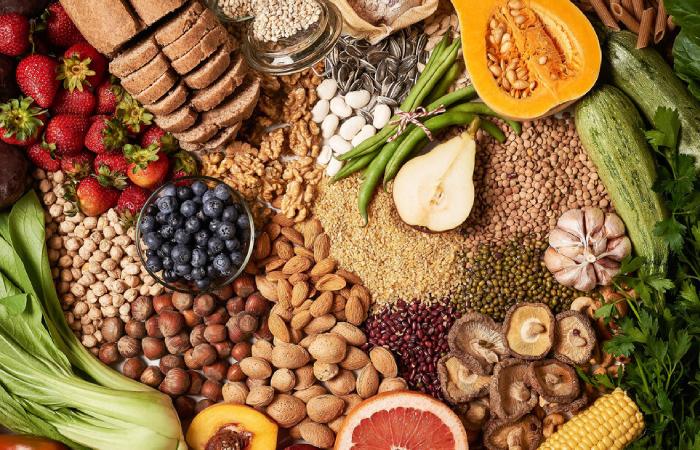There are many diets to select, but which is best for you? You can argue all day among the various popular meals out there, but mostly when emphasizing whole fresh food and minimally processed ingredients for good overall health. There is no discussion.
The Whole Foods diet is more of a lifestyle than a diet. Its goal is to maximize whole, fresh food and minimize processed and added ingredients. This method can be used to improve general health and stimulate weight loss. The best thing about this is that instead of a diet that can be used in the short term to promote weight loss or health, a whole-food diet can be maintained for a long time to improve overall health results.
Does it sound too good to be true? Read on to learn more about the whole food diet, the benefits of eating more real food, and how to start eating more and more all food today!
Table of Contents
What is a Whole Foods Diet?

The All-Foods Diet focuses on eating and cooking foods that are fresh and as close to natural as possible. Fare does not include additives such as sugar and preservatives with minimal processing. Foods such as fruits, vegetables, complete grains, seeds, nuts, and beans contain beneficial nutrients and vitamins and retain their natural fibers. These are usually removed or removed in the final product of processed foods.
For example, try the following meals to follow the complete food diet.
- Chicken breast heated with healthy fats and seasonings instead of chicken nuggets with preservatives and ingredients.
- Freshly baked potatoes instead of French fries.
- Whole grain bread instead of white bread.
- Fruits and green leafy vegetables are for fiber, nutrients, and vitamins, not supplements, to meet daily nutritional needs.
- Fresh berries should be served with breakfast instead of toasted cakes and a breakfast bar.
- So, a cup of coffee with a cream splash instead of mocha mixed with chocolate caramel stuffed with sweet syrup.
- For our vegetarian/vegetarian friends: instead of (some) plant-based meat alternatives that may be high in additives, with natural whole food ingredients like vegetables, Choose a hamburger made.
These are just a few samples, but your day is full of opportunities to make healthier whole-food choices. If you plan to eat naturally, ask yourself if you are trying to swallow whole. If you’re unsure, check for any sugar, starch, or processing oil added to the label. Below are some examples of highly processed foods that you may want to avoid or moderately enjoy when following a complete-food diet.
Foods to Avoid or Minimize:
- Fast food: French fries, cheeseburgers, chicken pieces, etc.
- Packaged foods: chips, muesli bars, frozen dinners, etc.
- Added sugar and sweets: soft drinks, juices, sweet cereals, cookies, candies, pastries, cakes, and more.
- Fine ounces: white rice, white pasta, white bread, etc.
- Processed animal products: Deli meat, sausage, bacon, beef jerky, etc.
- Vegetable-friendly processed foods: (partly) plant-based “meat,” fake cheese, etc. -Check the label. Some brands have been significantly improved by adding ingredients.
Benefits of a Whole Foods Diet
Benefits of a Whole Foods Diet – Here are four reasons to consider following an all-food diet. If you’re considering an all-food diet, there’s a lot to believe, but here are some of my favorites that make an all-food diet worthwhile.
1. Fewer Calories
If you switch to an all-food diet, you may be able to eat more and feel more satisfied throughout the day with the same number of calories. It is a tremendous advantage to focus on eating real whole food. Leaves the entire food as nature intended, without adding sugar, fat, or sodium. Eating whole food can reduce calories by adding the fat and sugar found in high-speed and processed foods.
2. More Nutrients

Foods in their natural state are high in nutrients such as vitamins C, A, magnesium, potassium, and fiber, more than many Americans can get. An easy way to increase your nutritional intake is to eat more nutritious foods! Many processed foods are delicious and help to make you feel full, but in the process, they often deprive you of healthy nutrients.
3. Increase Fiber
Fresh fruits, vegetables, whole ounces, and beans are very high in fiber, whereas many fast and processed foods are not. Wool is perfect for your health for various reasons, including promoting intestinal health and satiety. Studies have shown that a fiber-rich diet may help reduce the risk of heart disease and diabetes (1).
4. Healthy Fats
Including extra whole foods in your diet will help reduce the trans and flooded fats often added to fast and processed foods. On the other hand, eating real food makes highlighting the healthy fats found in natural food sources easier. When cooking with oil, choose healthy options such as olive oil, avocado oil, cold pressed safflower oil, and sesame oil.
How to Add Extra Whole Foods to Your Diet
The good thing about eating an all-food-rich diet is that it doesn’t have to be all or zero. So, that’s certainly possible if you want, but for many people, eating whole food and gradually adjusting to less processing is an easier change.
The things to avoid have already been broken down, so here are some general tips for incorporating whole food into your diet.
- Eat loads of fresh fruits and root vegetables and include them in all meals and light meals if possible.
- Eat more leafy vegetables packed with essential vitamins and nutrients!
- Choose fresh meat such as raw poultry, fish, pork, and beef. Remember that you can always cook at home with healthy oils and seasonings to control what you add to your final product and still make it delicious.
- Eat more beans. They are an excellent source of vegetable protein and fiber, rich in vitamins and nutrients.
- Choose whole grains, not sophisticated ones.
- Choose sugar-free beverages such as water, sparkling water, tea or coffee, freshly squeezed juice, or milk (Note: check for added sugar or milk alternatives such as almonds and cashews and sweeten. Select a plane instead).
- Choose whole natural food, such as fresh fruits and vegetables, hard-boiled eggs, or a handful of almonds, and choose a healthy snack.
When many start a whole food diet, it can be overwhelming to think about everything they can’t eat. Although the truth is that you have a healthy, complete food choice for all of your favorite foods, you may need to spend a little time understanding what they are.
If in doubt, stick to the outer edge of the grocery store, where you often find the freshest food. However, there are also healthy options for snack passages in grocery stores. Reading the food label will help you determine if a food or snack is a healthy choice. Generally, the food you eat is close to its natural state, so the fewer ingredients you have, the better!
